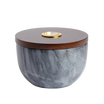Table of Contents
- Introduction
- 1. The Origins of Hashish – Ancient Beginnings
- 2. Spread Through Culture, Trade, and Religion
- 3. The Islamic Golden Age and Medicinal Use
- 4. Arrival in Europe and Colonial Curiosity
- 5. From Hippies to High Tech – The Modern Hash Renaissance
- 6. How Hash Is Made – Traditional vs. Modern Techniques
- 7. The Future of Hash: Legalization, Artisanal Craft & Wellness
- Conclusion
- About the Author
The Fascinating History of Hash: From Ancient Rituals to Modern Culture
Long before cannabis was debated in politics, regulated in dispensaries, or infused into boutique oils, it was pressed by hand, shared in ritual, and consumed in the form of hashish. Hash isn’t just a cannabis product — it’s a cultural artifact. A plant-based expression of spirituality, medicine, and art that stretches back more than a thousand years.
From its origins in ancient Persia and India to its spread across Sufi circles, French salons, and Moroccan kasbahs, hash has endured as a symbol of contemplation, creativity, and connection. Today, amid a modern cannabis renaissance, hash is returning to the spotlight — not as a relic, but as a refined, intentional alternative to over-processed extracts and over-hyped trends.
This in-depth guide explores hash’s remarkable journey: how it was born, how it traveled, how it evolved — and how it's being redefined for a new generation. Let’s inhale history together.
1. The Origins of Hashish – Ancient Beginnings
Hashish — also known as hash — is one of the earliest known cannabis concentrates. Its name is derived from the Arabic word ḥašīš, meaning “grass” or “dry herb.” But hash is more than just dried plant — it’s resin: the concentrated trichomes (glands) from cannabis flowers, carefully collected, pressed, and cured.
The exact origins of hash are hard to pinpoint, but scholars believe the practice of collecting and compressing cannabis resin began in regions where the plant grew natively: Persia, Central Asia, the Hindu Kush, and Northern India. References to cannabis resin can be found in ancient Ayurvedic texts, as well as early Persian poetry and Sufi mysticism.
Some historians link hashish to the legendary Assassins of Alamut — a sect of political radicals in 11th-century Persia whose name (and myth) became entangled with hashish in European retellings. While the connection is likely exaggerated, it’s evidence of how early hash captivated the imagination.
In India, a similar preparation called charas — made by rubbing fresh cannabis flowers between the palms — has been used for centuries in sacred contexts, particularly by Shiva-worshipping sadhus in the Himalayas. For them, cannabis was not just a plant — it was a sacrament.
What links these early hash cultures? Hands-on craftsmanship, deep ritual, and plant reverence. It was about touch, time, and intention — qualities still honored today by artisanal hashmakers around the world.
2. Spread Through Culture, Trade, and Religion
As ancient empires expanded, so did the cannabis plant and its concentrated form. Hashish traveled along the same routes as spices, textiles, and philosophy, from the Silk Road to the trans-Saharan trade networks. As it moved, it was absorbed into local cultures and took on new meanings — recreational, medicinal, and mystical.
In the Islamic world, hashish was widely used despite religious bans on alcohol. It became popular among mystics, poets, and laborers alike, who saw it as a tool for inspiration, relief, and introspection. The hash of 12th-century Baghdad, the hand-pressed bricks of Afghanistan, the sieved kief of Morocco — all trace their lineage to this period of cultural diffusion.
By the 13th century, hash was known across the Arab world, North Africa, Turkey, and India. In each place, it evolved with regional techniques and preferences — sometimes smoked in pipes, sometimes eaten as majoun (a cannabis-infused sweet), and sometimes venerated in sacred rituals.
This adaptability is part of hash’s power. It is at once universal and local — shaped by geography, tradition, and spirit.
3. The Islamic Golden Age and Medicinal Use
During the Islamic Golden Age (8th–13th centuries), hashish emerged not only as a recreational substance but as a subject of scientific and medical inquiry. Physicians like Avicenna (Ibn Sina) documented the plant’s therapeutic potential in treatises that would influence both Eastern and Western medicine.
While alcohol was largely prohibited, cannabis and its derivatives — including hash — were viewed through a different lens. Hashish was used in pain relief, digestive health, and mental balancing. It appeared in pharmacological texts and was part of the materia medica of the day.
Of course, hashish also held a controversial place in society. Some rulers banned it, others tolerated it. Sufi mystics used it for spiritual elevation, while religious authorities debated its effects on morality and cognition. These tensions foreshadow the debates we still see today — between healing and harm, medicine and misuse.
Still, the presence of hash in scholarly and spiritual circles shows just how deeply embedded it had become in Middle Eastern culture. It was more than an intoxicant — it was part of a medicinal and metaphysical tradition.
4. Arrival in Europe and Colonial Curiosity
Hashish first entered European consciousness during the Napoleonic campaigns in Egypt (1798–1801), when French soldiers encountered local customs of hash use. Returning to France, they brought with them not only exotic artifacts and spices — but pressed bricks of cannabis resin.
By the mid-19th century, hashish had found a strange new home in Parisian literary and scientific circles. It was available in pharmacies, sold in tinctures, and explored by writers like Baudelaire, Théophile Gautier, and members of the Club des Hashischins — a group dedicated to exploring altered states of consciousness.
French physicians experimented with hash to treat epilepsy, melancholia, and migraines. At the same time, colonial expansion brought European powers into deeper contact with North African hash cultures — especially in Morocco and Egypt — laying the groundwork for future regulation and prohibition.
What had been a mystical and medicinal plant was slowly being recast through a European lens: exotic, unpredictable, alluring — and eventually, suspicious. But before the crackdown, hash enjoyed a remarkable chapter as a cross-cultural muse and medical curiosity.
5. From Hippies to High Tech – The Modern Hash Renaissance
In the 20th century, hashish made its way to the West once again — this time through counterculture movements. During the 1960s and 70s, travelers along the Hippie Trail from Europe to India and Nepal returned with stories (and stashes) of potent black hash, pressed by hand and cured in Himalayan villages.
Moroccan, Lebanese, and Afghan hash dominated underground cannabis markets in Europe, offering a mellow, body-centered effect that contrasted with the racier high of high-THC flower. Often smoked with tobacco or in pipes, hash retained its roots in social ritual, music, and introspection.
But it wasn’t until the early 2000s that a true hash renaissance began — driven by legalization, lab testing, and extraction technology. Artisans started reviving traditional methods while applying modern standards: temperature control, terpene preservation, and solvent-free processes like ice water extraction and dry sifting.
Today, hash is no longer a relic of the past — it's a respected form of concentrate for connoisseurs. It’s also inspiring a new generation of flame-powered vaporizer users, who seek slow, analog methods to enjoy it without combustion.
Whether rolled into a joint, paired with a flower bowl, or gently vaporized in a Vapman Click or Lotus, hash is reclaiming its place in cannabis culture — as an intentional, artisanal experience.
6. How Hash Is Made – Traditional vs. Modern Techniques
All hash begins with trichomes — the resin glands on cannabis flowers that contain cannabinoids, terpenes, and flavonoids. Hash making is the art of collecting, refining, and compressing these trichomes into a dense, potent, and aromatic form.
Traditional Techniques:
- Hand-rubbed charas: Common in India and Nepal, this involves rubbing live cannabis buds between the palms to collect resin, then forming it into black, sticky balls
- Dry sift/kief: Dried cannabis is shaken or sieved through fine mesh screens to separate trichomes; this powder is then pressed into hash
- Pressed hash bricks: Popular in Morocco and Afghanistan, where resin is heat-pressed into solid blocks for transport and aging
Modern Techniques:
- Ice water extraction: Also called bubble hash, this method uses cold water and agitation to gently remove trichomes, which are then filtered and freeze-dried
- Rosin tech: Applying heat and pressure to flower or hash to squeeze out solventless oil — a hybrid between hash and modern concentrate
- Micron screen refinement: Using multiple screens and micron ratings to isolate the most resin-rich heads for a purer, more potent product
Each method has its champions, but all aim to do the same thing: preserve the essence of the plant — not just its THC, but its flavor, aroma, and soul.
When enjoyed through a clean vaporizer, especially one with full airflow and combustion-free design like the Vapman or Lotus, hash becomes an experience of nuance and presence — not just potency.
7. The Future of Hash: Legalization, Artisanal Craft & Wellness
As cannabis legalization expands globally, hash is re-emerging — not just as a retro curiosity, but as a premium product category. In legal markets like California, Spain, and parts of Canada, high-end hash is commanding attention from chefs, wellness brands, and flavor-focused consumers alike.
What’s driving the comeback?
- Terpenes & Taste: Hash preserves the plant’s aromatic fingerprint better than many solvent-based extracts
- Solvent-free methods: Modern techniques like bubble hash and rosin appeal to health-conscious users
- Low-dose rituals: Hash enables microdosing and slow, intentional consumption — not just intensity
Hash also aligns with a broader return to analog, artisanal, and sustainable living. Hand-pressed, ice-washed, air-cured — it’s cannabis the way it’s been made for centuries, now refined with precision and care.
And with tools like the Vapman Click, which vaporizes even sticky hash gently and evenly, or the Lotus with its convection heat plate, users can explore hash in its cleanest form — no flame, no combustion, just taste, effect, and breath.
Hash isn’t disappearing. It’s evolving. And it’s once again becoming a symbol — of quality, of culture, of conscious cannabis use.
Conclusion
From the hash bricks of ancient Persia to the sieved kief of Morocco and the bubble hash of California labs, hashish has traveled a long, winding path through time and culture. It’s been medicine, muse, outlaw, and icon — shaped by ritual, repression, and revival.
Today, hash represents a bridge between old and new — a way to consume cannabis that honors both tradition and innovation. For connoisseurs, it offers unmatched flavor and purity. For spiritual seekers, it reconnects us to ritual. And for the modern wellness user, it provides a clean, full-spectrum option that stands apart from overprocessed trends.
To inhale hash is to inhale history — and to honor the plant at its most concentrated essence.
Whether you’re new to concentrates or returning to your roots, explore how flame-powered vaporizers like the Vapman Click and Lotus can help you experience hash as it was meant to be — slow, flavorful, and free of compromise.
→ Explore analog vaporizers crafted for hash, herb, and breath
About the Author

Author: Michael Mussner, Founder of INHALE Vaporizers
Michael is a passionate vaporizer designer and entrepreneur from South Tyrol, driven by craftsmanship, sustainability, and the mindful use of natural herbs. With a background in product innovation and a love for analog technology, he founded INHALE to revive flame-powered vaporizers like the Vapman and Lotus. Every product he creates is deeply rooted in authenticity, simplicity, and a respect for nature.
Questions? Contact us here or email support@nowinhale.com.

















Leave a comment
All comments are moderated before being published.
This site is protected by hCaptcha and the hCaptcha Privacy Policy and Terms of Service apply.